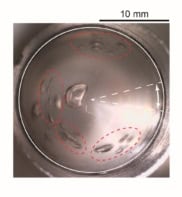Flash Physics is our daily pick of the latest need-to-know developments from the global physics community selected by Physics World‘s team of editors and reporters

Canadian lab licenses isotope-production technology
A consortium of Canadian research institutes including the TRIUMF accelerator lab in Vancouver has granted ARTMS Products a licence to use its proprietary technology to produce the medical-isotope technetium-99m using medical cyclotrons. These cyclotrons can be found in many large hospitals and the move is part of a Canadian effort to produce the isotope without the need for a nuclear reactor. This is necessary because the NRU reactor at Chalk River, Ontario – which currently supplies all of the technetium-99m used in Canada and the US – will stop making technetium-99m at the end of October. ARTMS is based in Canada and run by Paul Schaffer, who also heads up the life-science research division at TRIUMF. The technique involves firing a proton beam at a special target and then rapidly extracting the short-lived technetium-99m.
Marsquakes may help to sustain microbial life on the red planet
Seismic activity on Mars may produce enough hydrogen to sustain bacterial life. That’s the finding of an international team of researchers whose latest study found that rocks that are formed by the grinding together of others during earthquakes are rich in trapped hydrogen. The researchers – based at Yale University in the US, Brock University in Canada and the University of Aberdeen in the UK – say that although Mars in currently not very seismically active, their work suggests that “Marsquakes” could produce enough hydrogen to support small populations of micro-organisms for short periods of time. “This is just one part of the emerging picture of the habitability of the Martian subsurface, where other sources of energy for life may also be available. The best way to find evidence of life on Mars may be to examine rocks and minerals that formed deep underground around faults and fractures, which were later brought to the surface by erosion,” says Yale geophysicist Sean McMahon. The work is published in the journal Astrobiology.
PandaX-II sees no signs of dark matter

A 500 kg liquid-xenon detector in the world’s deepest underground laboratory has failed to see any hints of dark matter after running for nearly 100 days. The null result obtained by the PandaX-II experiment at the China JinPing laboratory allows physicists to put the most stringent upper-limit yet on the strength of the spin-independent interaction between weakly interacting massive particles (WIMPs) and ordinary matter. WIMPs are a favoured candidate for dark matter – a mysterious substance that appears to account for about 84% of the matter in the universe and has a profound effect on the formation of galaxies and other large-scale structures in the cosmos. Discovering a dark-matter particle would be an important step towards a theory of particle-physics beyond the Standard Model. There is more about the nature of dark matter in this video: “What is dark matter?“. The work is published in Physical Review Letters.
A deeper understanding of material interfaces
A new method that gives physicists a clearer look into the interfaces that exist between different materials has been developed by an international team of researchers. Their work could have many applications in modern electronic devices that are based on semiconductor heterostructures, as well as topological and correlated materials. The team, led by Vladimir Hinkov at Würzburg University, has uncovered important charge properties of correlated oxide interfaces with unprecedented atomic-scale resolution. The work helps to move away from conventional electronic chips based on p–n junctions – which are bulky and use a lot of energy – to transition-metal-oxide interfaces that display a variety of tuneable parameters. To better understand the behaviour of electrons in the latter interfaces, the researchers developed a new method, based on “resonant X-ray reflectometry”, and a new analysis software. The research is published in npj Quantum Materials.
- You can find all our daily Flash Physics posts in the website’s news section, as well as on Twitter and Facebook using #FlashPhysics. Tune in to physicsworld.com later today to read today’s extensive news story on quantum networks.



